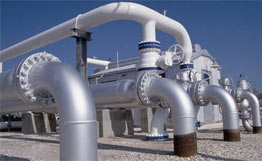
GAZPROM TOUTS AGREEMENTS WITH MOLDOVA AS “MODELS”
Publication: Eurasia Daily Monitor Volume: 4 Issue: 3
By:

On December 27, Moldova’s First Deputy Prime Minister Zenaida Grecianii signed an agreement on gas deliveries for 2007 with Gazprom president Alexei Miller. On December 30, chief executives of Gazprom and MoldovaGaz — which is majority-owned by Gazprom — signed a five-year agreement on guidelines for gas deliveries in 2007-2011. The negotiations had been quiet as well as secretive, and the political fallout nil. Gazprom is touting both agreements, especially the latter, as “models” applicable to other ex-Soviet countries.
Under the agreement for 2007, Gazprom is raising the price just slightly to $170 per 1,000 cubic meters, up from $160 that Moldova paid during the second half of 2006. The contracted volume apparently remains constant at 2.5 billion cubic meters for the year. The transit tariff for Russian gas exports via Moldova remains unchanged at $2.50 per 1,000 cubic meters for every 100 kilometers of pipelines on Moldovan territory. Moldova has transited 20 to 22 billion cubic meters of Russian gas annually to Balkan countries in the last few years. The pipeline’s capacity is 25 billion cubic meters per year — a transit potential of strategic scope.
The five-year agreement with Gazprom stipulates a gradual scale and timetable for bringing the price of gas supplied to Moldova up to a purported “European average price” minus transportation costs. Under this agreement, Gazprom will charge Moldova 75% of that price in 2008, 80 to 85% in 2009, 90% in 2010, and 100% of the “European average price” in 2011.
Reciprocating these presumed favors, Moldova hands over its internal gas distribution networks to Gazprom. Those networks were built in large part during the post-Soviet years from state, district, and municipal budgets and some private business funds. The government’s legal right to hand those networks over to a foreign party will not be immune to legal challenges. As a precautionary measure, the de facto handover to Gazprom may formally be carried out via MoldovaGaz.
Meanwhile, MoldovaGaz retains its existing ownership structure: Gazprom with 63.4% and the Moldovan government with 36%. Chisinau insists that the handover of the distribution networks should not change those proportions.
According to Gazprom spokesman Sergei Kuprianov, the agreements just signed with Moldova constitute a model for the type of relations Gazprom aims to build with other CIS member countries as well. The model’s essence is taking over those countries’ assets in return for Gazprom’s consent to a phased increase in the price of gas during a three- to five-year transitional period, at the end of which the price of Russian-delivered gas would equal the “European average” minus transport costs (Interfax, Itar-Tass, December 27, 30).
The unstated though obvious catch in this “model” is that Russia substantially determines European prices through its monopolistic practices along the entire supply chain, from upstream to end-users — a trend that profoundly marked energy politics in 2006 and seems set to continue this year. Moreover, countries on which this model is being experimented are asked to hand over their assets permanently and irreversibly, in return for only temporary relief on the pace of price increases, which can then continue in an open-ended manner.
Moldova, a member of the World Trade Organization, consented at the year’s end to Russia’s accession to the WTO, on the condition that value-added taxes on Russian gas deliveries to Moldova be levied in the country of destination, in accordance with WTO rules. Those taxes were being paid in Russia until now. Following year-long negotiations on this issue, Moldova signed the documents on Russia’s accession to the WTO in late December, presumably in return for Russia’s binding acceptance of the country-of-destination VAT collection.
Moldova had paid $80 per 1,000 cubic meters of Russian gas until January 1, 2006 — the highest price paid by any CIS member country during 1996-2005. In January 2006, Russia imposed a total cut-off in gas supplies to Moldova for 16 days — the longest such interruption suffered by any customer of Gazprom since 1991. Russia then raised the price to $110 for the first half of 2006 and $160 for the second half of the year, thereby doubling the price to Moldova within a 12-month period. Thus, the increase by “only” $10 per 1000 cubic meters for 2007 is no favor, but rather a consequence of the recent, steep price hikes on a buyer who is being pushed beyond the edge of solvency.
Russia supplies 100% of the gas consumed in Moldova. Alternative supplies from Romania are possible, but never materialized. Moldova imported 2.5 billion cubic meters of Russian gas annually in 2005 and some 2.3 billion cubic meters in 2006. The interruption of supplies in January 2006 and the mild weather toward the year’s end account for the decrease below the contracted level this year.
For its part, Transnistria consumed 1.1 billion cubic meters of Russian gas annually in the last few years. Officially recognized debts to Gazprom passed the $1 billion mark in 2004. According to Supreme Soviet chairman Yevgeny Shevchuk, Transnistria owes $1.2 billion to Gazprom as of mid-2006 (Itar-Tass, December 29, 2006). Thus far, Gazprom or the Russian government never seriously attempted to collect those debts.
Transnistria’s de facto authorities held a 13% stake in MoldovaGaz until withdrawing from the company in 2005. The following year, Moldova exercised its legal right to hand over that stake to Gazprom, thus raising the latter’s stake in MoldovaGaz to the present level of 63.4%. However, the gas distribution systems in Transnistria remain under those authorities’ physical control. For its part, Chisinau has paid its gas bill to Russia on schedule, in full and in cash for the almost a decade, but this fact is not preventing the monopoly supplier from grabbing the country’s remaining, meager national assets.
(Moldpres, Basapres, Interfax, December 26-January 4)




